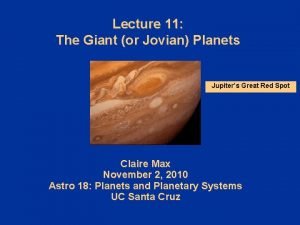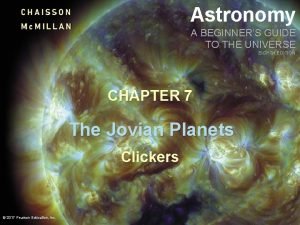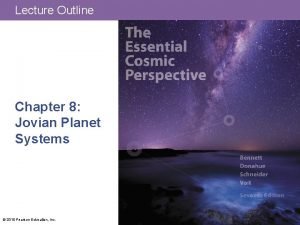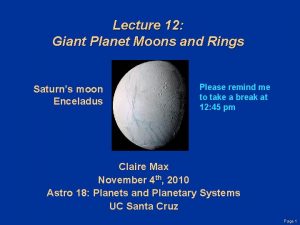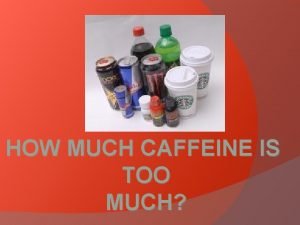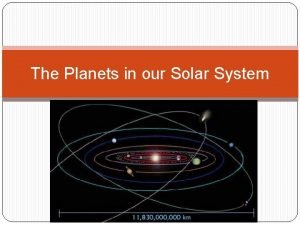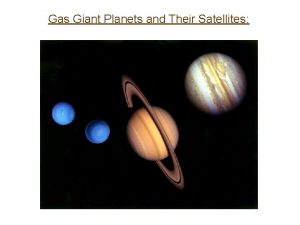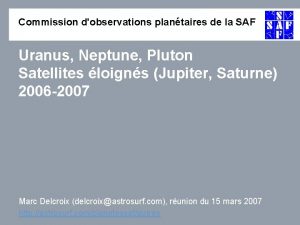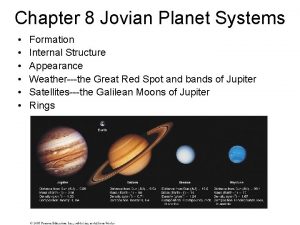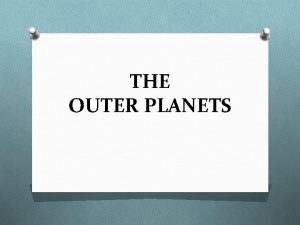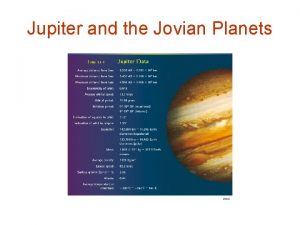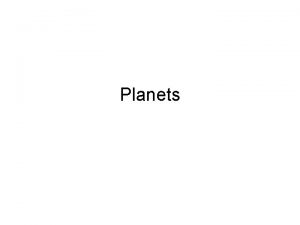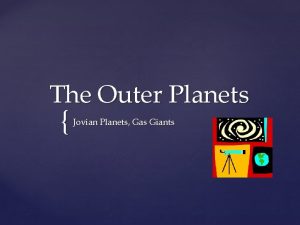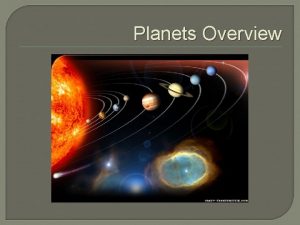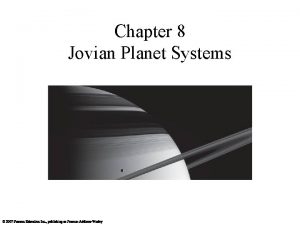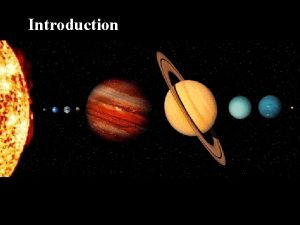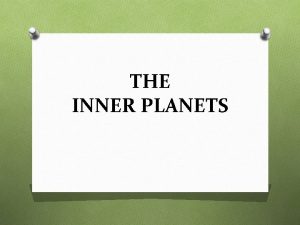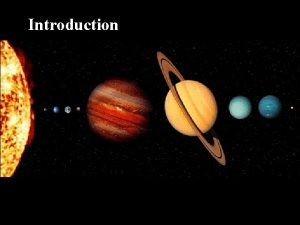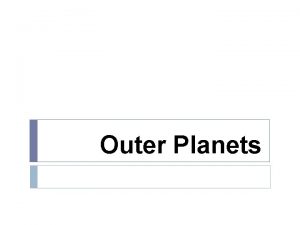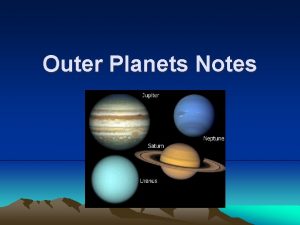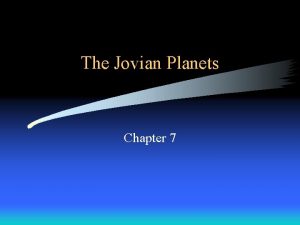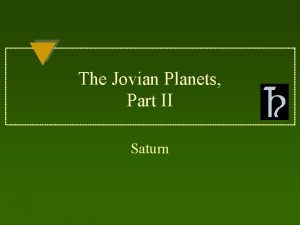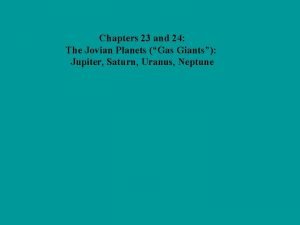The Jovian Planets The Jovian Jupiterlike Planets Much




































- Slides: 36

The Jovian Planets

The Jovian (Jupiter-like) Planets Much larger and more massive than terrestrial planets

The Jovian Planets Low density Composition: H, He, H compounds No solid surface

Jovian Atmospheres Colors are caused by different chemicals in the clouds

Jupiter’s Atmosphere Banding is caused by strong convection Bands alternate hot and cold

Saturn Cat the equator are no longer going as fast as they used to; Saturn may lose its place as the windiest in the solar system… Saturn has intense lightning storms

Sizes of the Gas Giants Jupiter has three times the mass of Saturn But is only slightly larger

Uranus’ Axis Polar axis is in the ecliptic No banding or clouds Odd weather due to axis tilt Blue because of methane

Uranus But in the IR, we do see storms and bands!

Neptune Interestingly, the Great Dark Spot has disappeared!

Jupiter’s Interior No real ‘surface’ Gaseous atmosphere Liquid and metallic hydrogen interior Earth sized core

Other Interiors Jupiter and Saturn are very similar Uranus and Neptune are similar

Other Interiors Saturn is different in that it: • • Has thicker clouds Has a thicker liquid hydrogen layer Has a smaller metallic hydrogen layer Has a larger core (but not more massive) because it has less gravity Saturn also has hydrogen “rain” still differentiating

Other Interiors Uranus and Neptune • • Cores about the same size as Jupiter & Saturn No liquid hydrogen Differentiated cores Much smaller than Jupiter & Saturn Why? Slower accretion captures less H

Rotation Jupiter: 9 h 50 m Saturn: 10 h 19 m Uranus: 16 h 34 m Neptune: 17 h 17 m High rotation rates cause them to be oblate

Rotation Differential Rotation Means different parts rotate slower/faster

Jupiter’s Magnetic Fields

Saturn’s Magnetic Field

Uranus & Neptune

Saturn’s Rings Saturn’s rings are made of small particles From large rocks to grains of dust

Saturn’s Rings

Clicker: Planetary Atmospheres Jovian planets have HUGE hydrogen atmospheres because A. they have massive cores and are cold B. they have massive cores and are warm C. they have no cores and are cold D. they have no cores and are warm

Clicker: Planetary Atmospheres Terrestrial planets have no hydrogen in their atmospheres because A. Hydrogen is light and terrestrial planets are warm. B. The Sun blows the hydrogen away. C. There was very little hydrogen in the disk when the Earth formed. D. All of the hydrogen got fused inside the Sun.

Clicker: Jovian Interiors Jupiter and the other jovian planets are sometimes called "gas giants. " In what sense is this term misleading? A. They are not in any sense "giants. " B. They actually contain relatively little material in a gaseous state. C. The materials they are made of are not the kinds of thing we usually think of as gases. D. Actually, it's a great description, because these worlds are big and gaseous throughout.

Clicker: Jovian Interiors Uranus and Neptune are smaller than Jupiter and Saturn because: A. Colder gas has less gravity and could not form such large balls B. The size differences are random coincidence. C. Particles were more spread out so accretion took longer & couldn’t form before the solar wind started D. Only rock and metal could condense at the distances of Uranus and Neptune.

Exoplanets One of NASA’s goals is to investigate the possibility of life on other worlds The question is… will it be obvious?

Detecting Exoplanets are planets that orbit a star that is not the Sun Methods of detecting: • Stellar “wobble” (astrometry)* • Direct detection* • Doppler shift • Transits

Direct Detection Only a few found… but maybe more soon!

Light: Doppler shift

Light: Doppler shift

Light: Doppler shift

Light: Doppler shift

Measuring Velocity If we know the REST wavelength of an emission line…

Detecting Exoplanets Transits can be detected by the light curve The transiting planet blocks some of the starlight

Detecting Exoplanets Kepler Space Telescope Confirmed: 1030 Candidates: 4696

Life…
 How are terrestrial planets different from jovian planets?
How are terrestrial planets different from jovian planets? Jupiter magnetosphere
Jupiter magnetosphere Jovian worlds
Jovian worlds Saturn is noticeably oblate because
Saturn is noticeably oblate because Jupiter's layers
Jupiter's layers Why do jovian planets have rings
Why do jovian planets have rings What is each planet made of
What is each planet made of Inner planets and outer planets
Inner planets and outer planets 9 planets
9 planets What separates the inner and outer planets?
What separates the inner and outer planets? How much is too much plagiarism
How much is too much plagiarism How much caffeine in a snickers bar
How much caffeine in a snickers bar To whom much is given much is required meaning
To whom much is given much is required meaning Whats the third planet from the sun
Whats the third planet from the sun Huygens
Huygens Neptune jovian
Neptune jovian Jovian
Jovian điện thế nghỉ
điện thế nghỉ Vẽ hình chiếu vuông góc của vật thể sau
Vẽ hình chiếu vuông góc của vật thể sau Một số thể thơ truyền thống
Một số thể thơ truyền thống Thế nào là hệ số cao nhất
Thế nào là hệ số cao nhất Ng-html
Ng-html Hệ hô hấp
Hệ hô hấp Thế nào là số nguyên tố
Thế nào là số nguyên tố đặc điểm cơ thể của người tối cổ
đặc điểm cơ thể của người tối cổ Các châu lục và đại dương trên thế giới
Các châu lục và đại dương trên thế giới Cách giải mật thư tọa độ
Cách giải mật thư tọa độ Chụp tư thế worms-breton
Chụp tư thế worms-breton ưu thế lai là gì
ưu thế lai là gì Tư thế ngồi viết
Tư thế ngồi viết Thẻ vin
Thẻ vin Cái miệng nó xinh thế chỉ nói điều hay thôi
Cái miệng nó xinh thế chỉ nói điều hay thôi Các châu lục và đại dương trên thế giới
Các châu lục và đại dương trên thế giới Bổ thể
Bổ thể Từ ngữ thể hiện lòng nhân hậu
Từ ngữ thể hiện lòng nhân hậu Tư thế ngồi viết
Tư thế ngồi viết Thế nào là giọng cùng tên
Thế nào là giọng cùng tên

